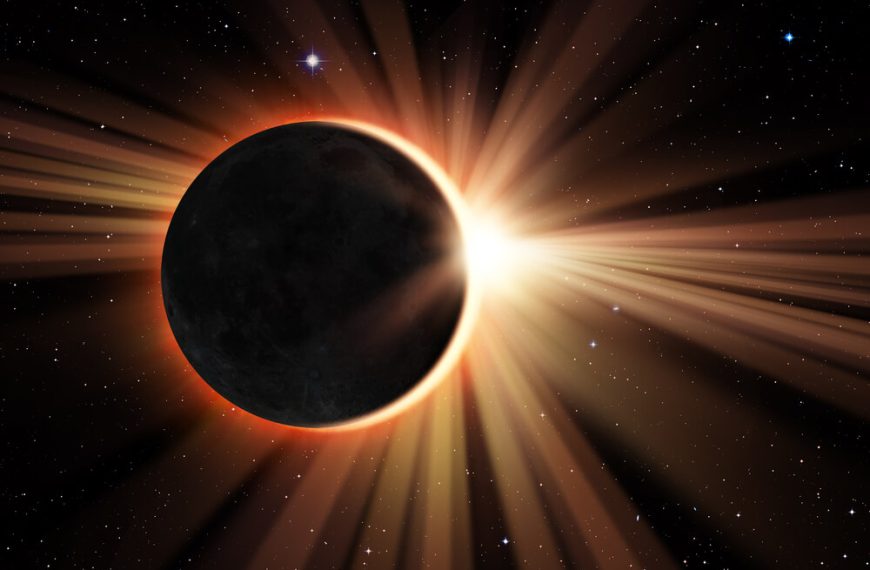Eclipses happen when a celestial body like the sun or moon moves into the shadow of another celestial body. A solar eclipse occurs when a new moon comes between the Earth and sun and blocks sunlight from reaching Earth. There are 4 types of solar eclipses and the annular eclipse is the second most common.
This eclipse gets its name from the Latin word ‘annulus’ which means ‘ring’. It has a characteristic ring of fire and the whole eclipse is called an annular solar eclipse. In most places and for most of the time it lasts, an annular eclipse looks like a partial solar eclipse. The maximum phase of this eclipse is referred to as annularity. The area on Earth where you can see the annular eclipse is called the path of annularity which is about 93 miles wide on average.
What Is an Annular Eclipse
An annular solar eclipse occurs when the moon covers the sun’s centre so that only the outer edges of the sun are visible like a fiery ring or annulus around the moon. During an annular eclipse, the New Moon is far from Earth and near a lunar node. The farthest point from the Earth is known as the moon’s apogee. The earth, sun and the new moon line up in a nearly straight line due to which a part of Earth is shadowed by the moon. The moon partially blocks sunlight from reaching the earth. The moon looks like a small dark disk on top of the sun and the edges of the sun appear like a ring around the moon which is often referred to as the ‘ring of fire.’
When do Annular Eclipses Occur
To be clear about what causes an annular eclipse, it’s important to understand the prevailing conditions.
- An annular eclipse occurs in the New Moon phase and the Moon should be very near a lunar node. This is necessary so that Earth, Moon and the Sun are in a straight line. The moon is at the apogee, which is its farthest point from Earth, because of which the outer edge of the Sun shows as a ring of sunlight or fire.
- Every lunar month, the distance between Earth and the Moon changes because the Moon’s orbit around Earth is elliptical and not circular. The reason we can see the ring of fire of the Sun in an annular eclipse is because the Moon is near its apogee and looks smaller than the Sun when seen from Earth.
- Solar eclipses are caused when the Moon’s shadow falls on Earth. There are 3 types of shadow that the New Moon can cast —the umbra, the penumbra, and the antumbra. To see an annular eclipse, you must be at a place where the Moon casts the antumbra shadow. At the maximum point, the annular path is about 93 miles wide but this can vary. considerably. At the centre of this zone, the annularity will appear as a perfect ring of fire. In other areas, where the Moon is not perfectly centred on the Sun, the width of the ring may vary. If you are on the periphery of the annularity path, you will probably see a broken ring of fire or bead-like blobs of light for a few seconds called Baily’s beads. This is because there are gaps in the mountains and valleys situated on the Moon’s surface that allow sunlight to escape at some places.
- The Earth’s orbit around the Sun is also not circular but elliptical like the Moon’s. At one point, the Earth is at its closest point to the Sun and at one point when it is at the farthest. The Earth’s distance from the Sun also can affect the type and duration of the eclipse.
● If you are wondering why annular eclipses occur so rarely and not on every New Moon, it’s because the Earth and Sun are aligned on opposite sides of the Moon and the New Moon is usually not visible from Earth. Also, it’s necessary that the New Moon has to be close to a lunar node as only then can it be perfectly aligned with Earth.
Stages of an Annular Solar Eclipse
There are 5 stages of an annular solar eclipse.
- 1st contact
- 2nd contact
- Maximum eclipse
- 3rd contact
- 4th contact
This is when a partial eclipse begins and the silhouette of the moon starts becoming visible in front of the sun. The sun looks as if a piece has been bitten out of it.
This is when the annularity begins and the ring of fire appears. For a few seconds, at the beginning of this stage, Baily’s beads can sometimes be seen at the edge of the moon’s dark image.
In this stage, the Moon covers the centre of the Sun.
In this stage, annularity begins to end. The Moon starts moving away from the Sun. At this time, Baily’s beads may be visible again along the Moon’s edge.
This is the stage where the partial eclipse ends and the Moon stops overlapping the Sun.
An annular eclipse lasts for about 6 hours. In locations where people can see the eclipse, it lasts for about 3 hours and the ring of fire can usually be seen for about 12 minutes. It occurs every one or two years.
Precautions During an Annular Solar Eclipse(
- You should avoid looking at the sun directly as the sun rays are usually very strong during this time. They can damage your eyes, burn your eye retinas and also make you blind.
- If you want to look at the eclipse, use a solar filter or wear eclipse glasses that don’t have scratches. These block all the rays from the sun and will not damage your eyes. You will be able to see the moon’s shadow over the sun very clearly when wearing these glasses. You can also project an image of the eclipse using a pinhole projector.
- Do not use regular sunglasses while looking at a solar eclipse. These do not protect your eyes as they only block a small percentage of the sun rays.
- Do not look at the sun through binoculars, an unfiltered telescope or a camera during this eclipse even if you are wearing eclipse glasses.
You probably have some clarity now about what causes an annular eclipse and any other questions you may have about why do annular eclipses occur and when do annular eclipses occur. An annular eclipse is a wondrous phenomenon and any one who sees it is awestruck.















